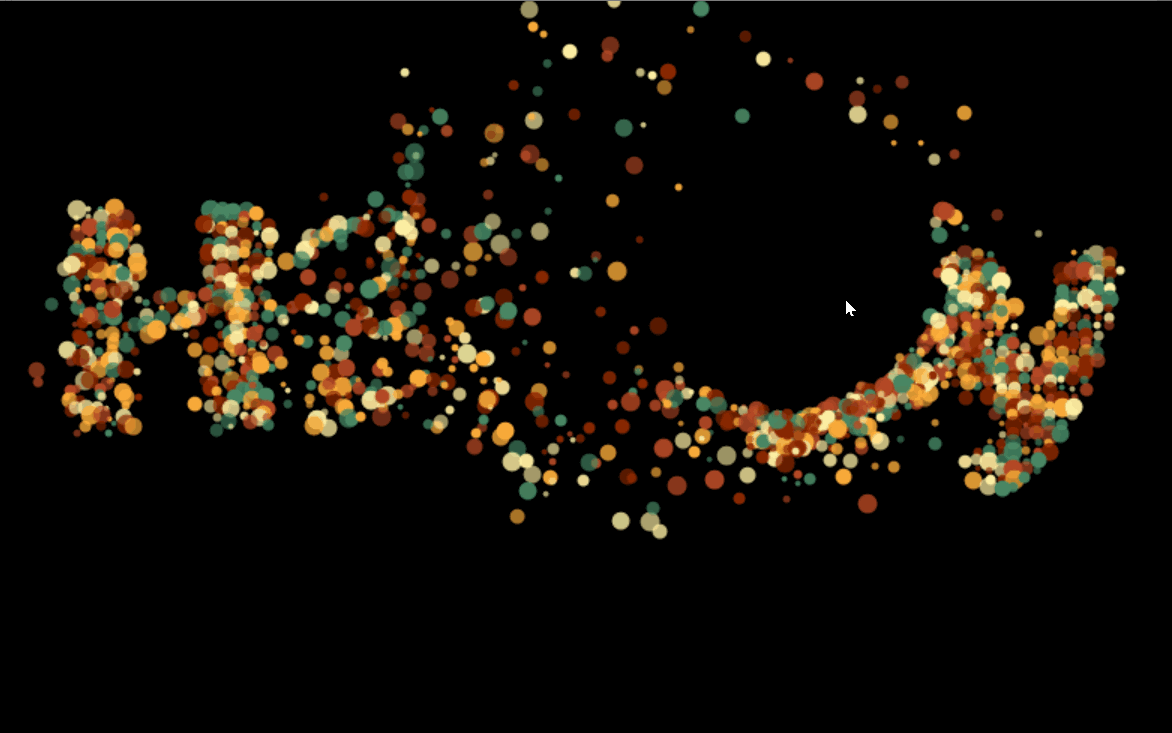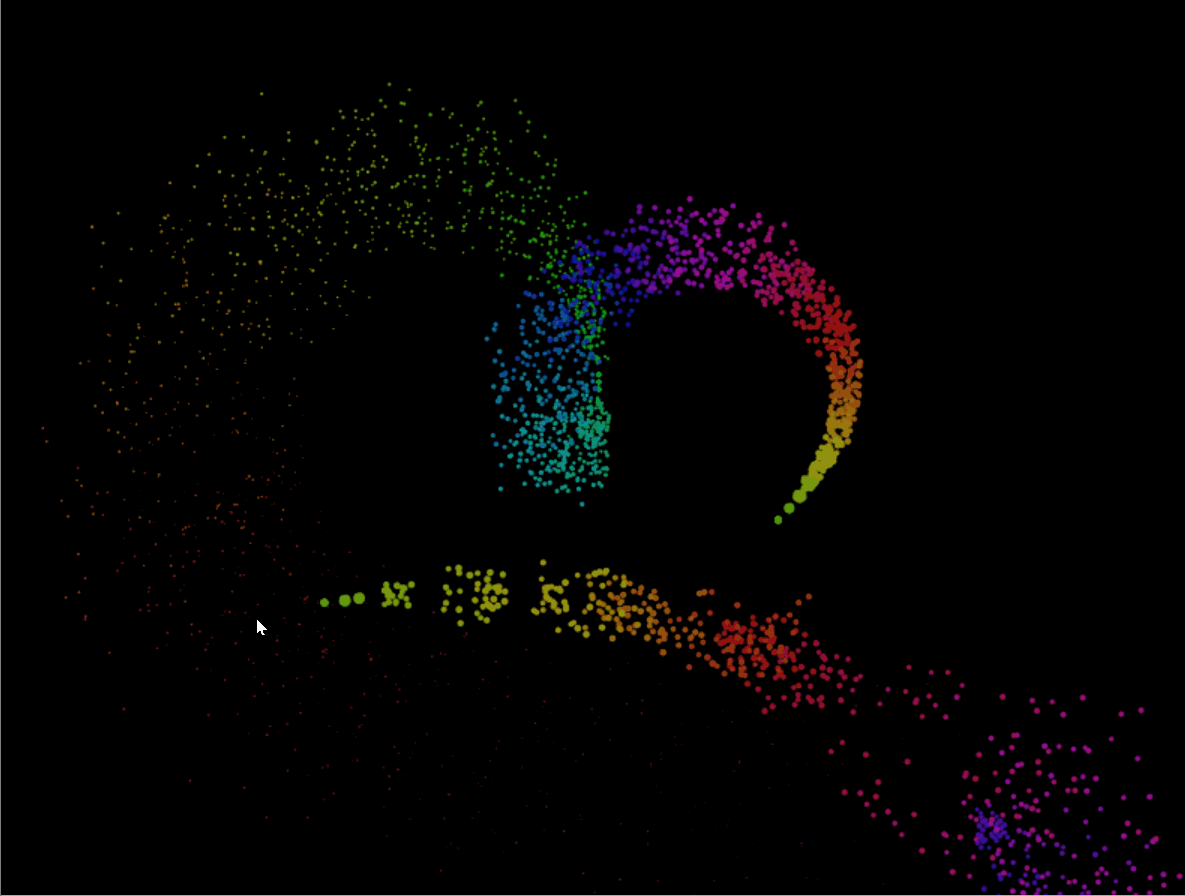用C# GDI编写粒子效果
C#语言能不能画一些动画特效呢?闲来无事,特过一把编程瘾。一共写了6个例子特效动画,界面如下,程序在文末供下载。


拿一个粒子效果“鼓泡泡效果”的类讲解,其他类似:
using System; using System.Collections.Generic; using System.Drawing; using System.Drawing.Drawing2D; using System.Drawing.Imaging; using System.Linq; using System.Runtime.InteropServices; using System.Text; using System.Threading.Tasks; using System.Windows.Forms; namespace CSharpGDI { /// <summary> /// 粒子效果2 /// </summary> internal class Particle2 { public struct ParticleObj { public int px;//圆点坐标x public int py;//圆点坐标y public int d;//直径 public int c;//颜色标识 1有颜色,0无色 public int a;//透明度 public Brush b;//画刷 public int vx; //原x public int vy; //原y public int vd; //原直径 } static List<ParticleObj> particles = new List<ParticleObj>(); static int speed =1; static Bitmap bmp = null; static Graphics g = null; /// <summary> /// 初始化 /// </summary> /// <param name="w">宽</param> /// <param name="h">高</param> /// <param name="span">间距</param> public static void Init(int w,int h,int size=15,int span=5) { particles.Clear(); Random rnd=new Random(); int r0 = Math.Min(w / size, h / size); for (var x = 0; x < w / r0; x++) { for (var y = 0; y < h / r0; y++) { ParticleObj p = new ParticleObj() { px = x * r0 + (r0 - span)/2, py = y * r0 + (r0 - span)/2, d = r0-span, c = rnd.Next(2), a = rnd.Next(100, 255) }; p.vx = p.px; p.vy = p.py; p.vd = p.d; Brush b = new SolidBrush(Color.FromArgb(p.a, 255, 255, 255)); if (p.c == 1) b = new SolidBrush(Color.FromArgb(p.a,72,209,204)); p.b = b; particles.Add(p); } } bmp = new Bitmap(w, h, PixelFormat.Format32bppArgb); g = Graphics.FromImage(bmp); } /// <summary> /// 动画 /// </summary> /// <param name="mouseX">鼠标x坐标</param> /// <param name="mouseY"></param> /// <param name="w">宽</param> /// <param name="h">高</param> /// <param name="R">圆的半径</param> public static Bitmap Start(int mouseX, int mouseY, int w, int h, int R=150) { if (particles.Count == 0) Init(w,h); g.Clear(Color.Black); g.SmoothingMode = SmoothingMode.AntiAlias; Random rnd = new Random(); for (var i = 0; i < particles.Count; i++) { var p = particles[i]; if (R * R > (p.px - mouseX) * (p.px - mouseX) + (p.py - mouseY) * (p.py - mouseY)) { if (p.px > mouseX) p.px += speed ; if (p.px < mouseX) p.px -= speed; if (p.py > mouseY) p.py += speed ; if (p.py < mouseY) p.py -= speed; if (rnd.Next(2) == 1) { p.d = (p.d+speed*5 >w/2?w/2:p.d+speed*5); } else { p.d =(p.d- speed*5<=0?10:p.d-speed*5); } } else { if (p.px > p.vx) p.px = p.px - speed < p.vx ? p.vx : p.px - speed; if (p.px < p.vx) p.px = p.px + speed > p.vx ? p.vx : p.px + speed; if (p.py > p.vy) p.py = p.py - speed < p.vy ? p.vy : p.py - speed; if (p.py < p.vy) p.py = p.py + speed > p.vy ? p.vy : p.py + speed; if (p.d > p.vd) { p.d -= speed; } if (p.d < p.vd) { p.d += speed; } } particles[i] = p; g.FillEllipse(p.b, p.px - p.d / 2, p.py - p.d / 2, p.d, p.d); } return bmp; } } }
效果如下:

思想很简单,Init() 方法根据屏幕大小和相关粒子大小参数产生粒子对象数组particles,然后在Onpait事件中反复调用Start()绘制粒子即可。其中可以根据鼠标位置,改变粒子大小和位置。
当点击“”鼓泡泡“”按钮事件:其实核心只是调用了pictureBox1.Refresh()方法而已,其他逻辑都不重要。
private void btnParticle2_Click(object sender, EventArgs e) { if (btnParticle2.Text.Contains("停止")) { btnParticle2.Text = "鼓泡泡效果"; animations.Clear(); } else { animations.Clear(); ResetButtons(); btnParticle2.Text = "停止鼓泡泡效果"; animations.Add("鼓泡泡"); ReStartCalFps(); pictureBox1.Refresh(); } }
pictureBox1.Refresh()方法会触发pictureBox1的pictureBox1_Paint事件,在该事件中添加逻辑:
//重绘事件 private void pictureBox1_Paint(object sender, PaintEventArgs e) { if(animations.Count==0) return; if (animations.Contains("抹纱窗")) { currbmp=Particle1.Start(mousePoint.X,mousePoint.Y,pictureBox1.Width,pictureBox1.Height,100,V); pictureBox1.Image = currbmp; CalFps(); } if (animations.Contains("鼓泡泡")) { currbmp = Particle2.Start(mousePoint.X, mousePoint.Y, pictureBox1.Width, pictureBox1.Height,150); pictureBox1.Image = currbmp; CalFps(); } …… }
其他几个效果展示:
文字粒子效果:

爱心效果:

写完之后感受就是,C#也是可以写出炫酷的粒子效果的,而且不卡顿很丝滑。
其中几个关键点:
1. 窗体设置双缓存:
public Form1() { DoubleBuffered = true; //设置双缓冲 InitializeComponent(); }
2. 在Paint事件中重绘粒子,不要在While(true)之类的循环里无间隔调用。Winform中的Paint事件就相当于JavaScript中的requestAnimationFrame事件。
3. 每次重绘调用的方法统一返回一张Bitmap图片,换句话说就是把全部的粒子画到一张Bitmap中,不能直接用pictureBox1.CreateGraphics()的Graphics对象来画粒子。否则会出现卡顿。而且这个Bitmap要用公共变量,不能每次调用都重新创建,否则内存会疯涨。
4.取像素点的数据要用内存拷贝法,不可直接调用img.GetPixel(i ,j).R ,否则性能极差,粒子一多也会出现卡顿。
内存拷贝法取像素点代码如下:注意其中的Data.Stride属性,用LockBits返回的像素数据每一行会有个补全操作,若采用Format24bppRgb格式也就是每个像素占用24位,3个字节分别表示B,G,R,且每行长度为Stride,不足Stride的会补全。
Bitmap bmp=new Bitmap(w,h, PixelFormat.Format24bppRgb); BitmapData data = bmp.LockBits(new Rectangle(0, 0, w, h), ImageLockMode.ReadWrite, PixelFormat.Format24bppRgb); int length = h * data.Stride; byte[] RGB = new byte[length]; System.IntPtr Scan0 = data.Scan0; System.Runtime.InteropServices.Marshal.Copy(Scan0, RGB, 0, length); for (int y = 0; y < h; y++) { int index = y * data.Stride; for (int x = 0; x < w; x++) { if (x % span == 0 && y % span == 0) { particles.Add(new ParticleObj() { x = x, y = y, vx = x, vy = y, vspeed = 2 }); //改变颜色。 RGB[index + 3 * x] = 255; RGB[index + 3 * x+1] = 255; RGB[index + 3 * x+2] = 255; } } } System.Runtime.InteropServices.Marshal.Copy(RGB, 0, Scan0, length); bmp.UnlockBits(data); g.DrawImage(bmp,0,0);
程序下载:Demo
源码已经上传到 https://github.com/tuyile006/CShparGDIParticle






 浙公网安备 33010602011771号
浙公网安备 33010602011771号